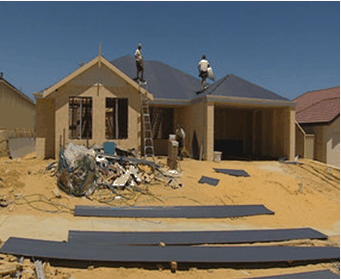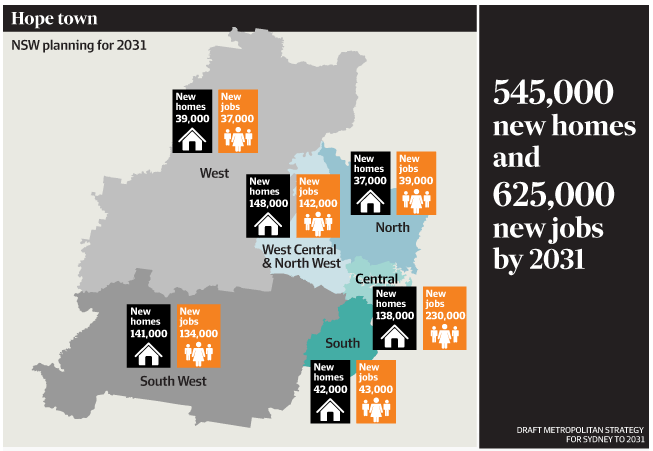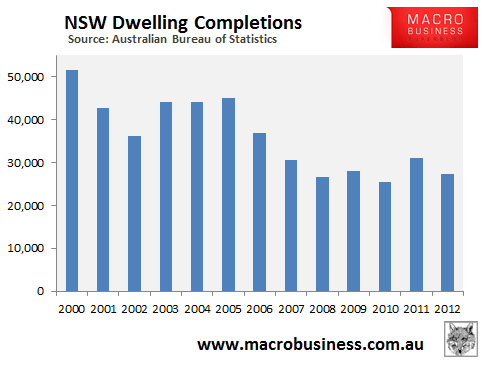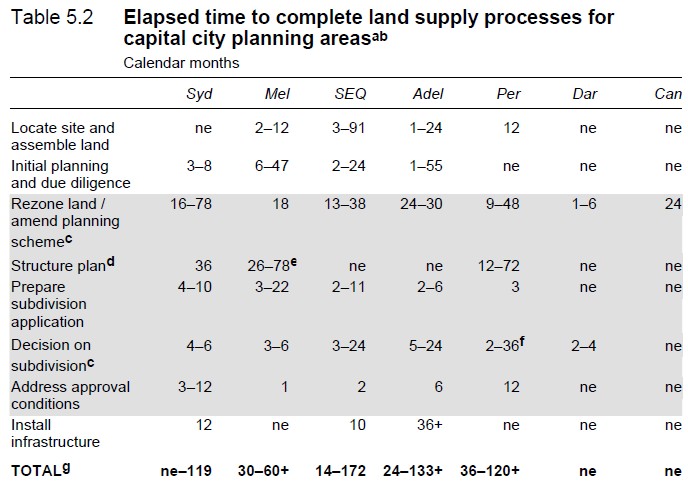
Following on from yesterday’s post on the New South Wales Government’s plan to significantly boost Sydney’s housing supply, the AFR has today provided more information on the initiative, as well as some of the potential road blocks surrounding it.
First, the AFR has included the below map showing where the Government intends the 545,000 new homes to go:

As you can see, most (328,000) homes are expected to be built in Sydney’s west, which planning mininster, Brad Hazzard, describes as the“treasure in Aladdin’s cave”, in reference to its role in unlocking much needed housing supply on Sydney’s fringe and reducing congestion across Sydney’s transport networks.
As shown above, the Government also hopes to “create” new jobs to match the new homes, so that Sydney-siders are not required to commute long distances for work. While the goal is admirable, the overwhelming majority of jobs in the economy are created by the private sector. Other than significantly lowering land prices in these new areas and providing flexible multi-use zoning (in order to encourage the establishment of new businesses), I don’t see how the Government can expect to “create” these new jobs.
According to the AFR article:
The associate director of industry research and forecasting firm BIS Shrapnel, Kim Hawtrey, said the plan was an overdue step in the right direction, but weakness in the construction sector was a problem.
“One of the constraints will be the availability of skills. We’ve lost about 50,000 construction jobs Australia-wide. What they’re proposing is potentially going to run into supply-side constraints. Who’s going to build these homes?” Mr Hawtrey said.
An average of 14,500 homes have been built in Sydney every year for the past five years, and the government will have to build 27,500 new dwellings every year in Sydney to reach its target. Mr Hazzard admitted that, while new housing starts were improving, they were still well off the mark.
This is a good point by BIS Shrapnel, but not insurmountable. While dwelling construction has fallen sharply over the past five years, New South Wales built far more homes in the early-2000s, suggesting that construction could ramp-up again (see next chart)

Moreover, there are likely to be a large pool of excess construction workers as the mining investment pool unwinds, many of whom could shift into housing and infrastructure construction.
There are also concerns about the planning system:
While the initial response of planners and lobby groups has been overwhelmingly positive, an antiquated planning system threatens to undermine the government’s plan.
Chris Johnson, the chief executive of developer lobby group Urban Taskforce, said that for development to happen there must be a way to get land rezoned and developed quickly.
“Unless there are ways to remove regulatory blockages to appropriate development, nothing will happen for many years no matter what the strategy document says,” he said.
The Urban Development Institute of Australia said the plan needed to be supported by bold policies to reduce levies on new-home buyers.
These are all valid points and will be crucial in determining the success of the plan. In its 2011 planning report, the Productivity Commission, noted that it took up to 119 months (nearly 10 years) to complete land supply processes in Sydney, with much of this time consumed by rezoning (see next table).

Taxes on new homes are also excessive, with the Housing Industry Association recently estimating that around $75,000 of direct taxes are levied on a new house in Sydney, on top of another $27,000 of “excessive” infrastructure charges.
Despite these potential road blocks, the New South Wales Government has signalled its intention to get housing policy back on track, which should hopefully lead to flow-on reforms and a significant liberalisation of housing supply across Sydney.

